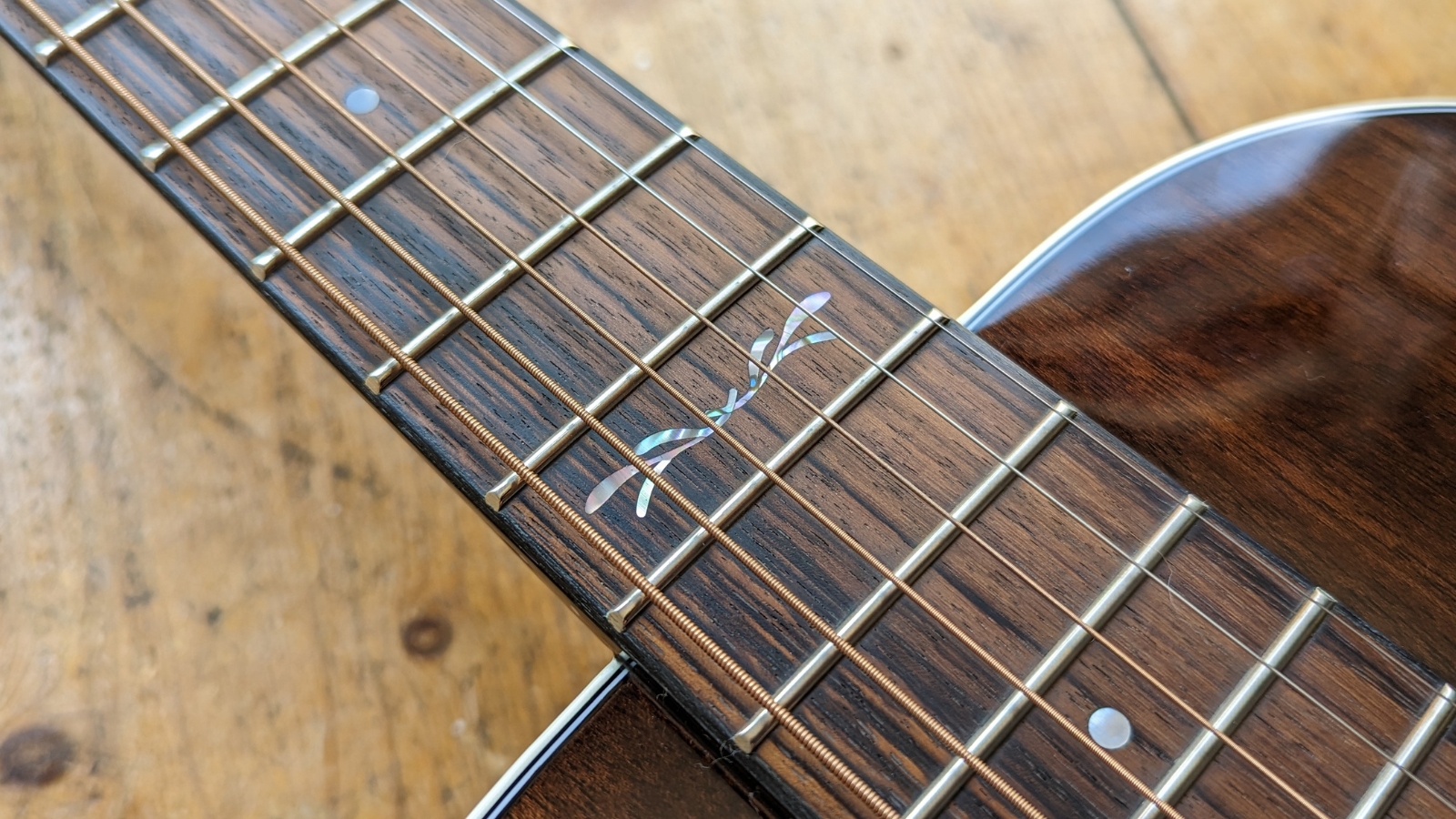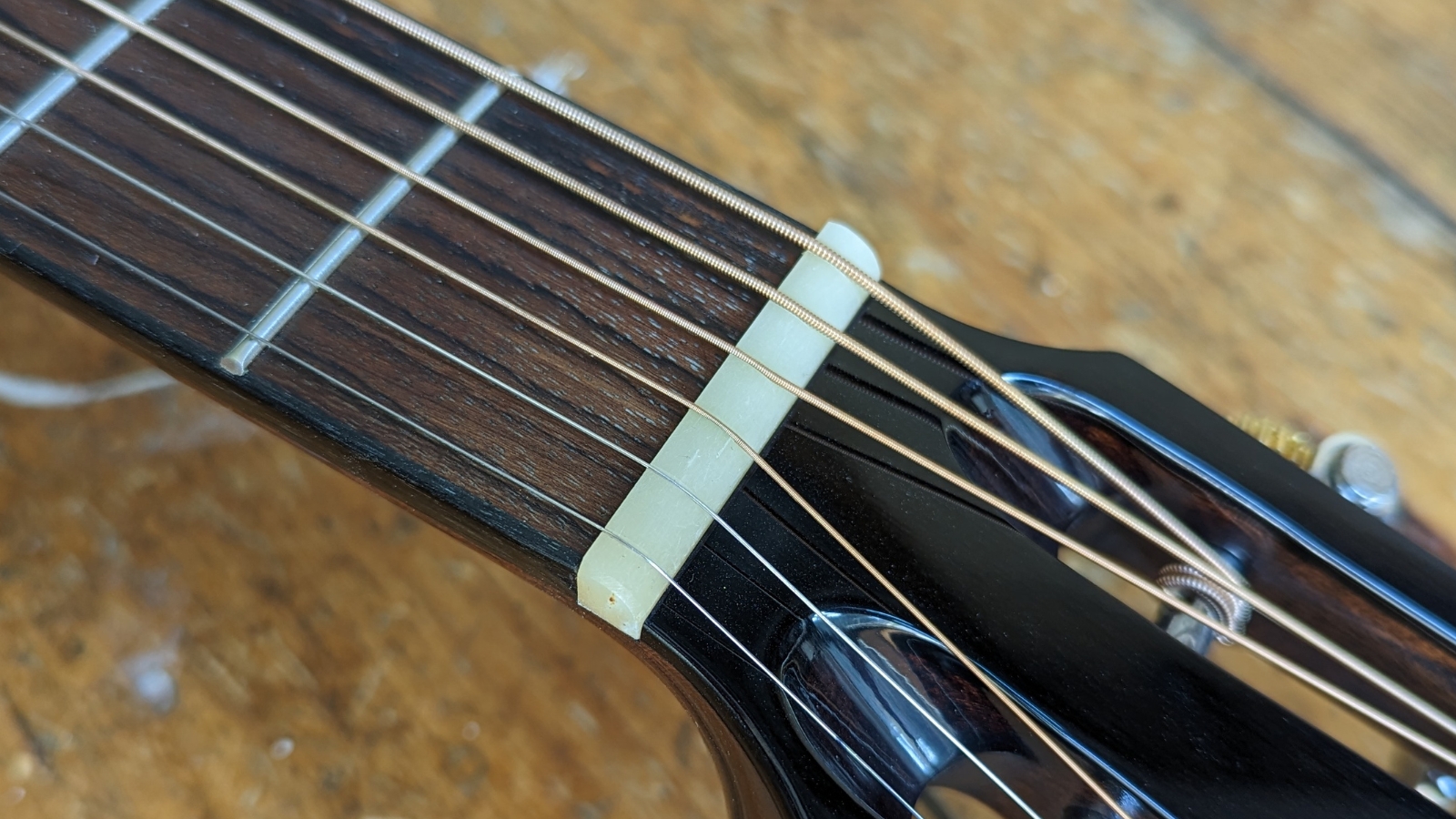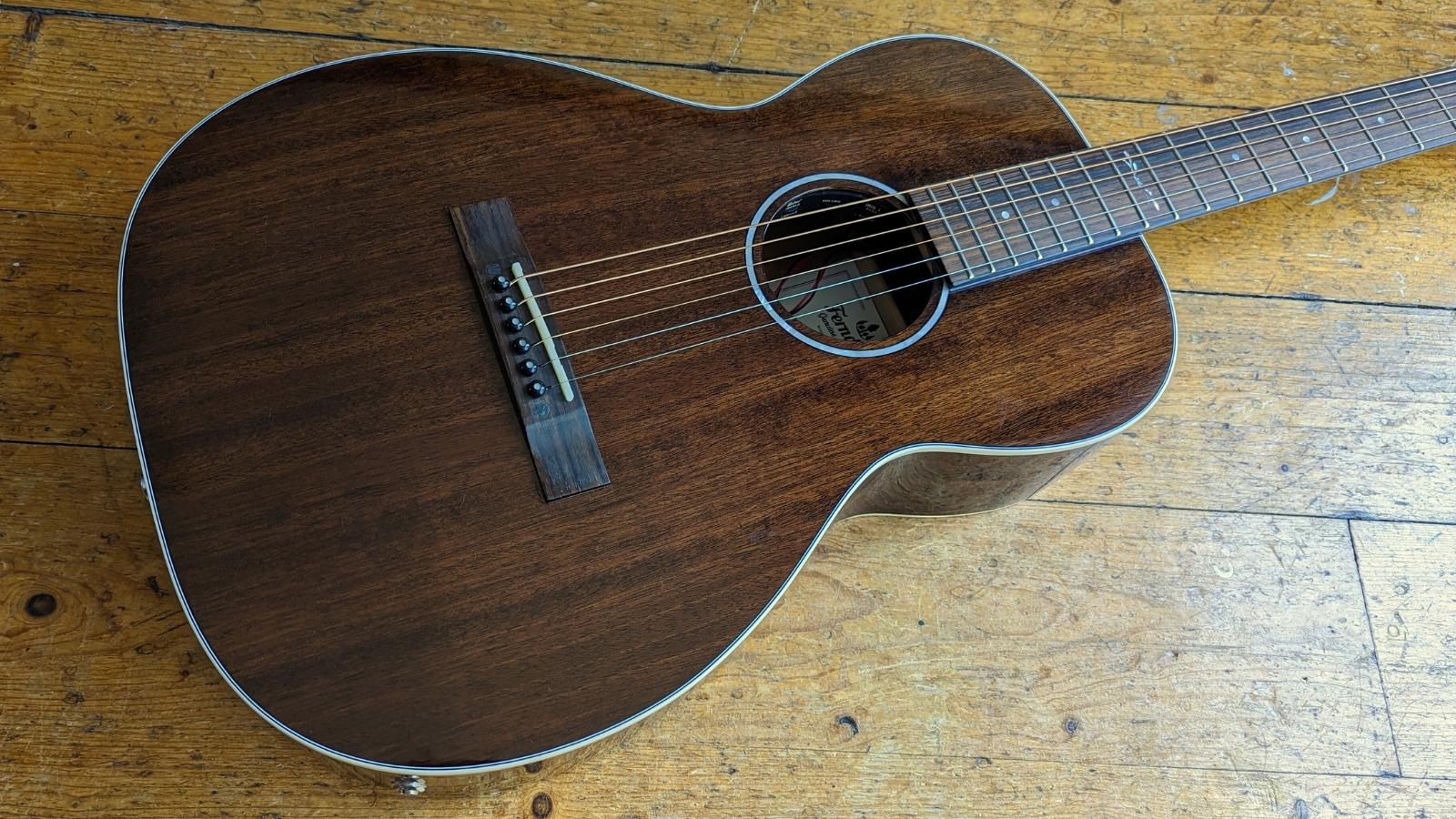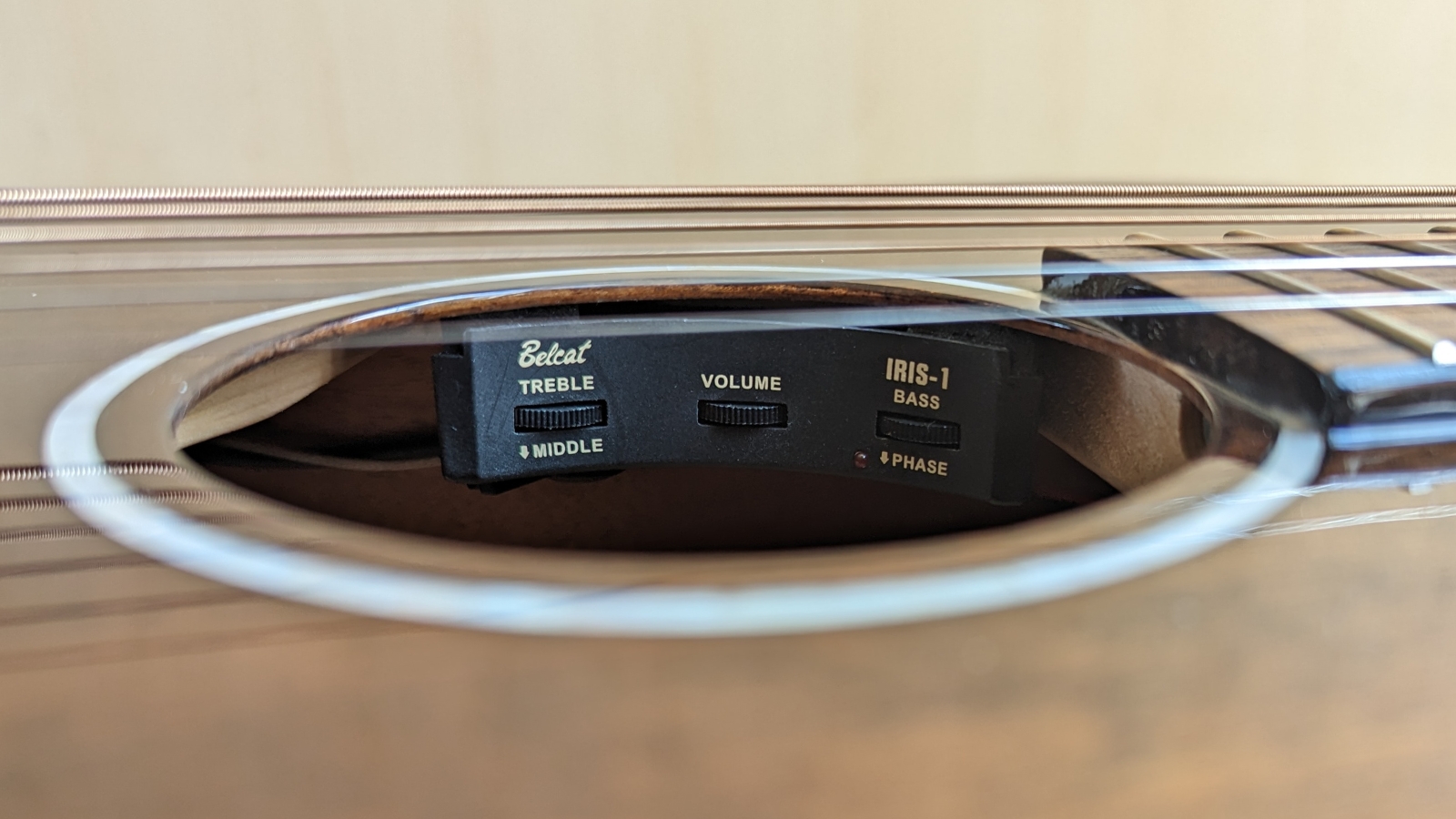MusicRadar Verdict
A lovely-sounding parlor acoustic guitar that will be great for beginners or those looking for something to pick up and play around the house. More than capable of competing with the bigger brands, the Ferndale P3-E offers great value for money and excellent playability.
Pros
- +
Excellent build quality
- +
Great setup out of the box
- +
Lovely sparkly sound
- +
Solid Mahogany top
Cons
- -
Electronics are uninspiring
- -
Not the loudest unplugged
MusicRadar's got your back
Ferndale P3-E Parlor review: What is it?

Just as huge musical instrument manufacturers like Fender and Gibson have begun selling their products direct, more and more traditional retailers are looking to their own brand instruments to offer something new to musicians. It’s something we see a lot over in the UK and Europe, which will no doubt spread further and farther afield as it gains popularity.
Brands like Harley Benton from Thomann and Sub Zero from Gear 4 Music are already fast becoming staples of rehearsal rooms and small gigs, and with the cost of living hitting everyone, it appears own brand gear is here to stay for the foreseeable future.
Enter into the fray, the Ferndale P3-E Parlor electro-acoustic guitar, sent to us for review courtesy of longstanding UK retailer PMT. Ferndale Guitars are aiming to disrupt the beginner acoustic guitar market by offering solid tonewood tops, excellent hardware, and awesome playability straight out of the box. There’s a lot of competition in this space, so can they compete with the big-name brands? Let’s find out.
Ferndale P3-E Parlor review: Features

Opening the box to pull the P3-E out, we’re immediately taken aback by the looks. It appears far more expensive than it is with a beautiful looking solid Mahogany top and layered Sapele back and sides that give it a cohesive aesthetic. More premium touches like the 12th fret inlay, rosette, and wood binding help it stand out from the crowd of bland beginner acoustics.
The build quality is really nice and we can’t see any defects anywhere upon closer inspection. The slotted headstock is presumably to save weight and prevent the P3-E from being top-heavy, something that can plague guitars with smaller and lighter bodies. The tuners are open-gear with a gold pinion gear and chrome tuning post. A bone nut and saddle are welcome additions to any acoustic and well received here considering the price point of the guitar.
Finishing off the spec sheet we’ve got a Rosewood fretboard with a 16-inch radius and an aesthetically pleasing grain that runs down the length of the neck. Tucked away in the soundhole is a Belcat Iris-1 electronics system with three-band EQ and a phase switch, more on which later. Now we’ve got the basic functionality out of the way, let’s dive into how the Ferndale P3-E actually plays.
Ferndale P3-E Parlor review: Playability

Out of the box, the setup is fantastic and we’ve got zero complaints here. Could the action be a tad lower? Yes, but that would come more down to personal preference than anything else. The neck is lovely and smooth on the back end with no new neck stickiness and the fretboard has a nice balance of slick playability and a bit of grip for you to dig in when bending the strings.
Could the action be a tad lower? Yes, but that would come more down to personal preference than anything else.
The body joins the neck at the 12th fret which means the E-minor blues scale is ever so slightly out of reach, although if you really stretch you can squeeze some lead licks in if they’re not too taxing. The narrow nut width of 42mm will make things feel slightly cramped for players with bigger hands, for us it’s manageable with a little practice on how we typically fret chords and once we get into the swing of things we found ourselves no longer actively thinking about its smaller size.
The slightly smaller neck width and frets that are closer together really do encourage faster playing and coupled with the low action, make it super comfortable to play. With this thing lying around the house we found ourselves wanting to pick it up and play regularly. The body is small enough to make wielding it a breeze and great for fitting in somewhere in a busy living room, as well as being manageable for younger players and those of smaller stature.
Ferndale P3-E Parlor review: Unplugged sound

So the Ferndale P3-E has nailed it in terms of build quality and playability, but how does it sound? Well, we needn’t have worried because it’s a great-sounding guitar overall. We start with our favorite pastime in some fingerpicking and there’s plenty of sparkle and articulation here, as well as some gorgeous overtones that build the harder you pluck. Thanks to the Mahogany top it's not overly bright, but still has plenty of cut on the treble strings.
It reacts really well to dynamics and of course, due to the body size, there’s a slight lack of low-end oomph. But we actually found that it gives the guitar a more balanced sound, as you don’t have to be so careful with your thumb not to overpower what you’re playing on the treble strings. This means you can just concentrate on playing without focusing overly on your technique, making it an excellent playing partner for fingerstyle.
Whipping out a pick we proceed to strum it to within an inch of its life. It’s certainly not the loudest acoustic we’ve ever played and to be honest, it’s a little uninspiring at higher volumes. We much prefer it played quieter, where arpeggiated chords and open strings allow the best of its character to shine through.
As it’s a parlor guitar, by definition it's designed to sit in your living room to be picked up and played at random. Thus we can’t really fault it for not filling the room with sound as our dreadnought guitars do.
Ferndale P3-E Parlor review: Plugged-in sound

Next, we proceed to plug it into our amplifier and see how it reacts and here we find the first real negative of the Ferndale P3-E. Our initial bugbear is with the placement of the controls themselves. We know that soundhole-mounted electronics are all the rage but in this instance, they’re rather awkwardly placed.
The controls aren’t mounted where your picking hand naturally lies across the body, instead being angled towards the neck side of the soundhole. We’d have preferred they lean more towards the bridge of the guitar for ease of use and it took us a while to get used to the placement.

Gretsch G9511: The dinky size and great tone at low volumes make it an ideal guitar for front-room strumming and picking.
Art & Lutherie Roadhouse Tennessee Red: It’s got attack, projection, volume, character, and style. And it’s only a parlor.
Alvarez AP66SB Artist 66 Parlour: A sharply styled instrument that's just what a parlor of this price should be.
To save on space, the middle EQ control is mounted underneath the control set, so it faces the back of the guitar, which again makes things rather awkward. In fact, when we first got a hold of it we spent a good five minutes trying to work out exactly where it was as you can’t even see it when you’re peering through the soundhole.
This placement also means it's impossible to play and adjust the control at the same time, something that can be crucial in speeding up your sound check when playing live and reacting to a demanding sound engineer’s demands.
We could forgive all this if the plugged-in sound blew us away but in all honesty, we found it to be a pretty drab experience. The bass control goes from nought to flabby pretty much instantaneously and the overall tonality is thin and ice-picky rather than full and rich.
There’s none of the warm sparkle and dynamic you get when the guitar is unplugged but admittedly, this is a characteristic of many onboard acoustic electronics, particularly at lower price points. If we really decided we wanted to use this guitar live, we’d go for an external acoustic guitar pickup instead.
Ferndale P3-E Parlor review: Conclusion
We’ll caveat our negative final point by reminding ourselves that this is a parlor guitar, it’s supposed to stay at home and for that purpose, it’s absolutely brilliant. We loved picking it up and noodling on the sofa whilst waiting for our partner to get ready before going out, as well as being able to have it by our side during screen breaks whilst working from home.
Whilst you’re not going to want to take it to a show with you and play live, it’s got an inspiring enough unplugged sound that it’ll make a great guitar for writing chord progressions and riffs on. For beginner guitarists, we can see it being a great introduction to the world of acoustic guitar thanks to its easy playability and small size.
Ferndale P3-E Parlor review: Hands on demos
Ferndale P3-E Parlor review: Specifications
- Top: Solid Mahogany
- Back & Sides: Layered Sapele
- Fingerboard: Rosewood
- Fingerboard Radius: 16"
- Body Style: Parlor
- Electronics: Belcat IRIS-1, 3-Band EQ
- Tuners: Chrome Open-Gear
- Scale Length: 24.4"
- Nut Width: 42mm
- Neck Width: 42.2mm (nut), 53.6mm (12th fret)
- Neck Depth: 21mm (1st fret), 24.4mm (9th fret)
- String Spacing: 34.8mm (nut), 53.6mm (bridge)
- Contact: Ferndale

Matt is a Junior Deals Writer here at MusicRadar. He regularly tests and reviews music gear with a focus on audio interfaces, studio headphones, studio monitors, and pretty much anything else home recording-related. Matt worked in music retail for 5 years at Dawsons Music and Northwest Guitars and has written for various music sites including Guitar World, Guitar Player, Guitar.com, Ultimate Guitar, and Thomann’s t.blog. A regularly gigging guitarist with over 20 years of experience playing live and producing bands, he's currently studying Sound Engineering and Music Production at Spirit Studios in the UK.
Brace yourself: Bryan Adams didn’t buy his first real six-string in a five and dime
“Nobody listens to one genre. I literally don’t know anybody who listens to one genre. You can be a fan of so many different artists at once”: Laufey on what Gen Z can teach the rest of us about how to appreciate music
Bon Iver - ranked: from Sable, Fable to For Emma, Forever Ago










